The Armed Services Vocational Aptitude Battery (ASVAB) is a crucial test for anyone looking to...
ASVAB Electronics Information: Key Concepts and Study Tips
Overview of the Electronics Information Section
The Armed Services Vocational Aptitude Battery (ASVAB) test is a significant step for those aspiring to join the U.S. military. It assesses various skills and knowledge areas to determine the best fit for military occupational specialties. One of the key sections of the ASVAB is the Electronics Information (EI) section. This portion of the test evaluates a candidate’s understanding of electrical concepts, systems, devices, and related terminology. For those aiming for technical roles within the military, excelling in the Electronics Information section is crucial.
This article will provide a comprehensive guide to the key concepts covered in the ASVAB Electronics Information section, along with study tips to help you prepare effectively. By mastering these concepts and applying practical study strategies, you can significantly improve your chances of achieving a high score and qualifying for your desired military career.
Key Concepts and Tips for Effective Study
1. Basic Electrical Concepts
Electricity and Circuits
- Electricity: The flow of electric charge, typically measured in amperes (A). It's essential to understand the difference between direct current (DC) and alternating current (AC).
- Circuits: A complete path for electricity to flow. Circuits can be series, parallel, or a combination of both. Understanding how current, voltage, and resistance interact in different circuit configurations is fundamental.
Study Tips:
- Use visual aids like circuit diagrams to understand how circuits function.
- Practice calculating total resistance, current, and voltage in series and parallel circuits using Ohm’s Law (V = IR).
2. Electrical Components
Resistors, Capacitors, and Inductors
- Resistors: Components that resist the flow of electrical current. Their resistance is measured in ohms (Ω).
- Capacitors: Devices that store electrical energy in an electric field, measured in farads (F).
- Inductors: Components that store energy in a magnetic field when electrical current flows through them, measured in henrys (H).
Study Tips:
- Familiarize yourself with the symbols and functions of each component.
- Learn the color code for resistors to quickly determine their resistance values.
3. Ohm's Law and Power
- Ohm's Law: Defines the relationship between voltage (V), current (I), and resistance (R): V = IR. It is a fundamental principle in understanding how electrical circuits operate.
- Power: The rate at which electrical energy is transferred by an electric circuit. Power is measured in watts (W) and calculated using the formula P = VI, where P is power, V is voltage, and I is current.
Study Tips:
- Practice solving problems involving Ohm’s Law and power calculations.
- Use real-world examples to see how these principles apply in everyday electronics.
4. Magnetism and Electromagnetism
- Magnetism: The force exerted by magnets when they attract or repel each other. Key concepts include magnetic fields and magnetic force.
- Electromagnetism: The interaction of electric currents and magnetic fields. Understanding how electromagnets work and their applications in devices like motors and generators is crucial.
Study Tips:
- Use experiments or simulations to see electromagnetism in action.
- Study the right-hand rule to determine the direction of magnetic fields around current-carrying conductors.
5. Semiconductor Devices
- Diodes and Transistors
- Diodes: Components that allow current to flow in one direction only, used in rectifying circuits.
- Transistors: Semiconductors used to amplify or switch electronic signals. They are the building blocks of modern electronic devices.
Study Tips:
- Learn the different types of diodes and transistors and their symbols.
- Understand the basic operation of these devices and their roles in circuits.
6. Digital Electronics
- Logic Gates and Circuits
- Logic Gates: Basic building blocks of digital circuits that perform logical operations like AND, OR, NOT, NAND, NOR, XOR, and XNOR.
- Digital Circuits: Systems that use logic gates to perform complex functions, including memory storage and data processing.
Study Tips:
- Use truth tables to understand how different logic gates work.
- Practice designing simple digital circuits using combinations of logic gates.
Effective Study Strategies for the ASVAB Electronics Information Section
1. Use a Study Guide A comprehensive ASVAB study guide is invaluable. It provides detailed explanations of concepts, practice questions, and test-taking strategies specific to the Electronics Information section. Use the guide to structure your study sessions and track your progress.
2. Practice with ASVAB Tests Taking practice tests is one of the best ways to prepare for the ASVAB Electronics Information section. It helps you get familiar with the format of the questions, identify your strengths and weaknesses, and improve your time management skills. Make use of free ASVAB practice tests available online.
3. Focus on Weak Areas Identify the topics you find most challenging and devote extra time to studying them. Use additional resources like online tutorials, videos, and textbooks to deepen your understanding of these areas.
4. Join Study Groups Studying with others can provide motivation and different perspectives on difficult concepts. Join a study group or find a study partner to discuss topics and quiz each other.
5. Use Flashcards Flashcards are a great way to memorize key terms and concepts. Create flashcards for important definitions, formulas, and component symbols, and review them regularly.
6. Hands-On Learning Whenever possible, apply what you’ve learned in a practical setting. Building simple circuits, experimenting with electronic components, and using simulation software can enhance your understanding and retention of electronic concepts.
The ASVAB Electronics Information section may seem daunting, but with the right approach and preparation, you can master it. Focus on understanding the key concepts, use a variety of study resources, and practice regularly to improve your confidence and performance. Remember, consistent effort and a strategic study plan are key to success.
Ready to start your ASVAB journey? Take our mini-practice test on our website to assess your current level and get personalized tips for improvement. For more ASVAB study materials and resources, be sure to visit Llibra. Good luck with your studies and your future military career!




